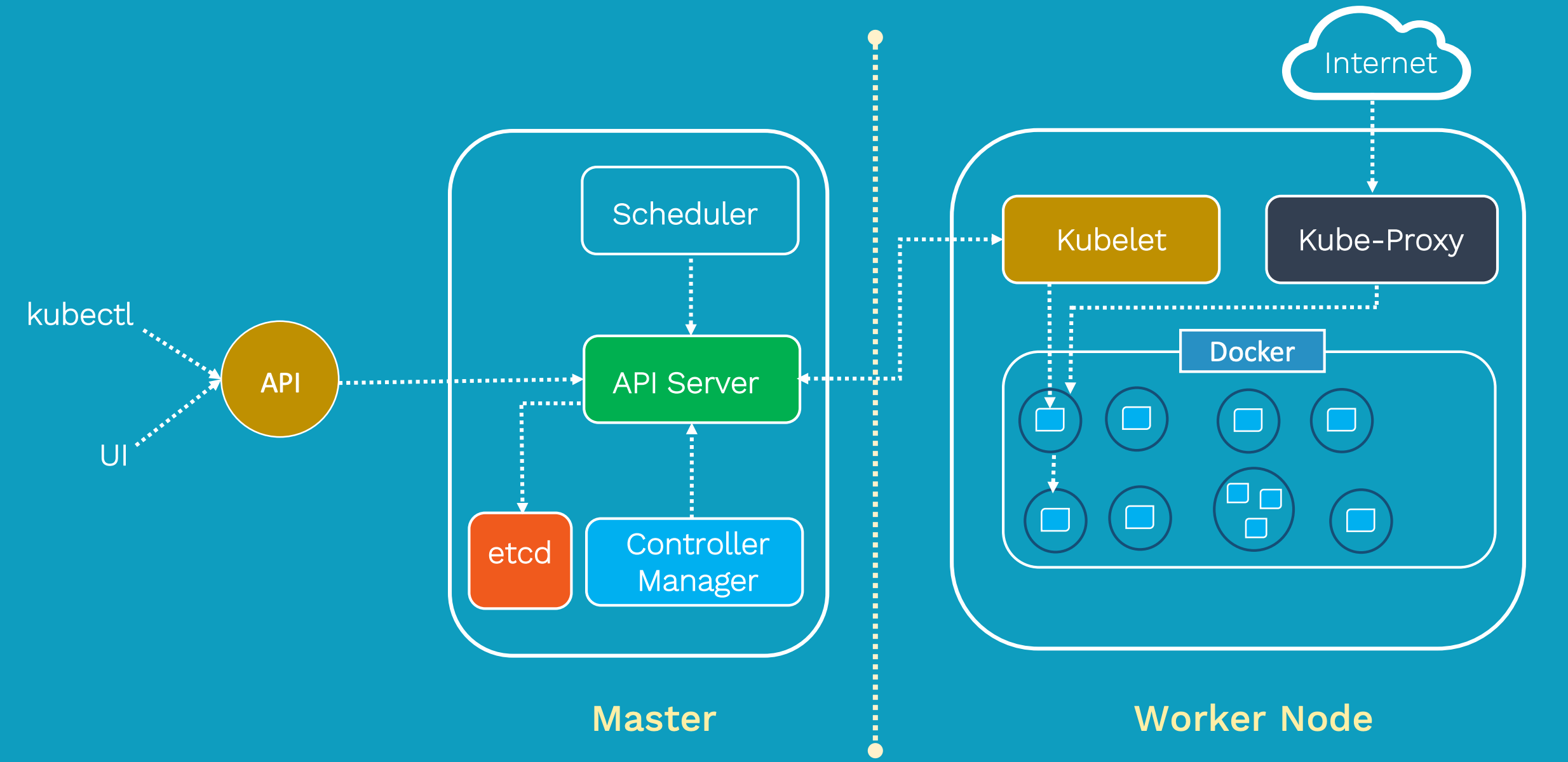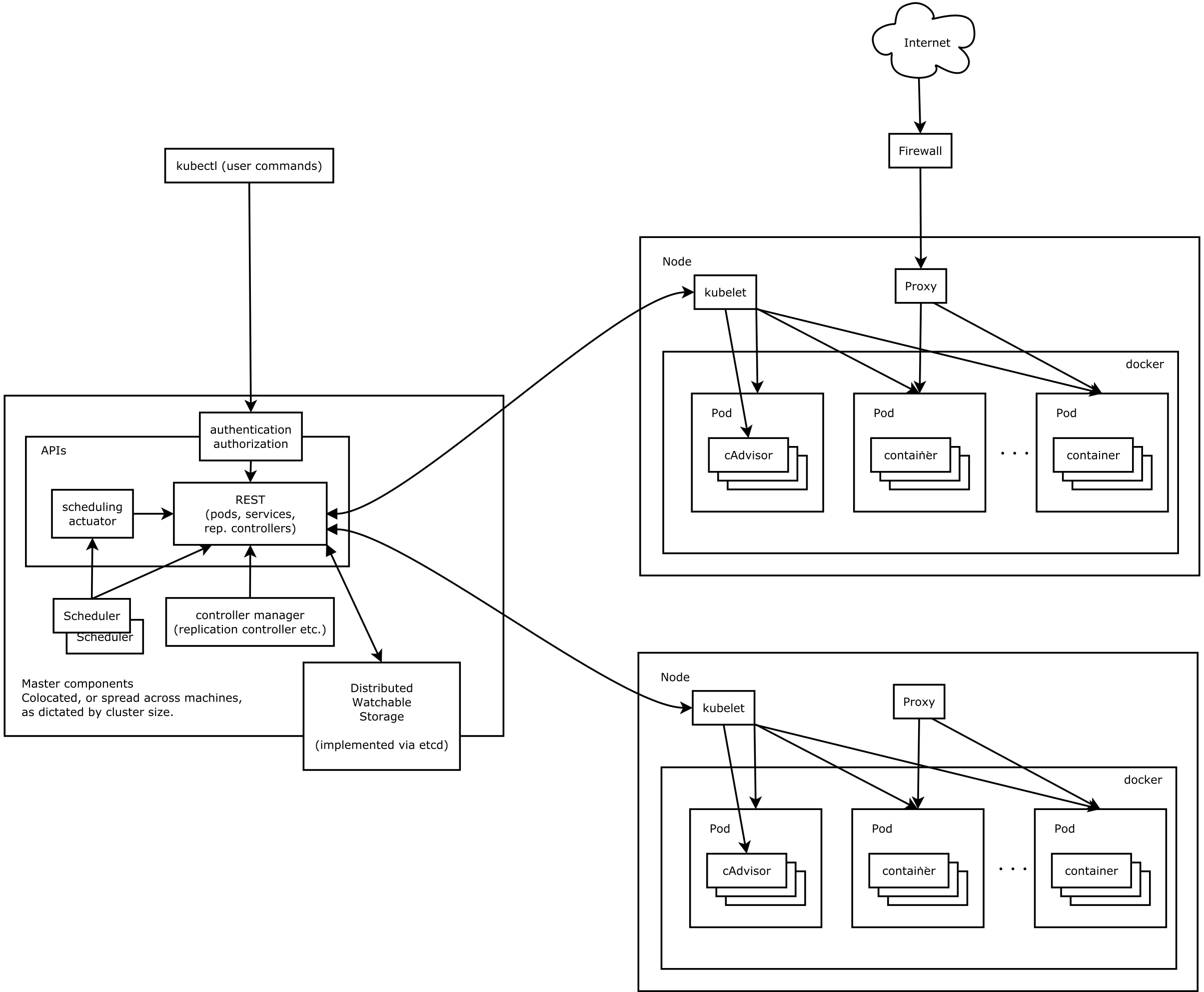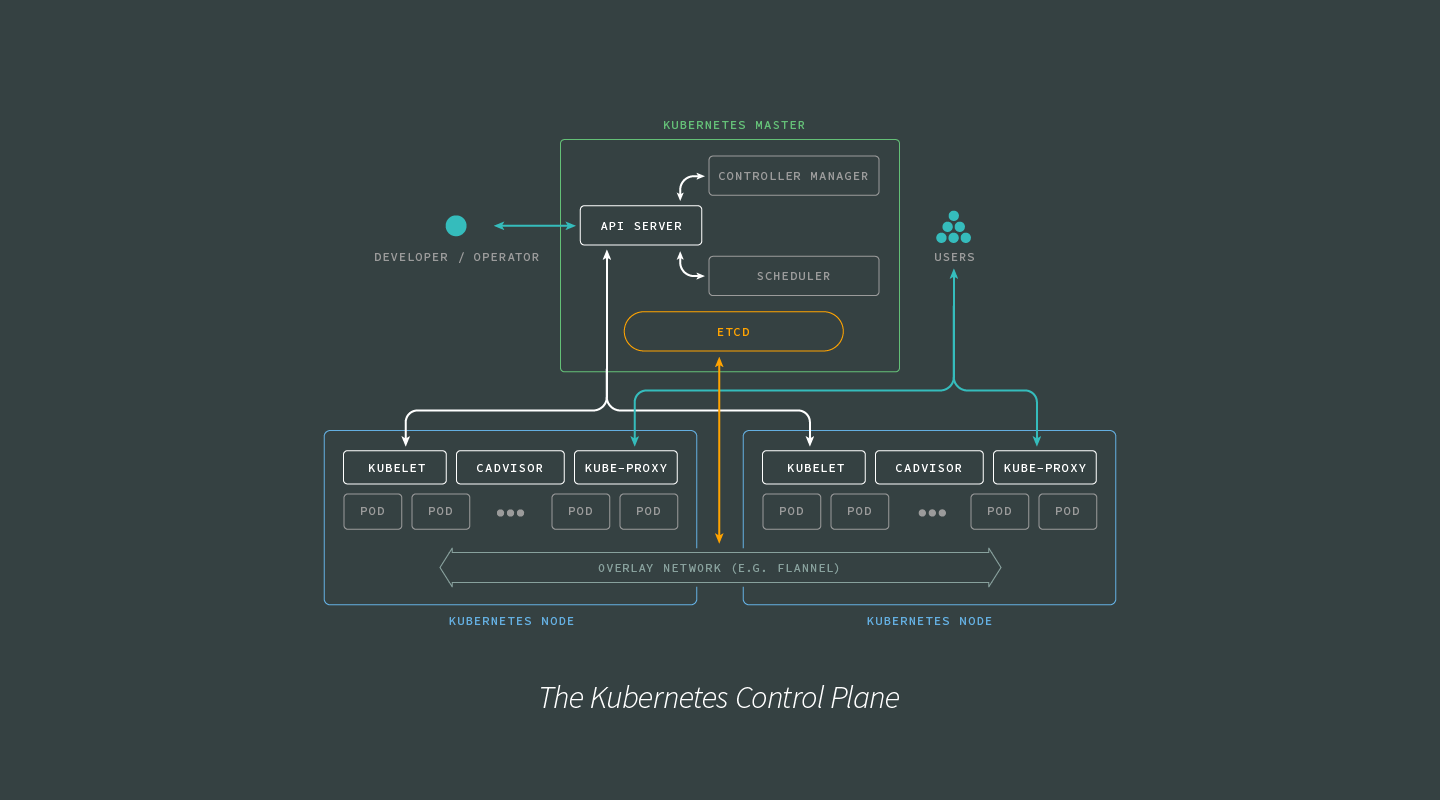
In this post, we will look at Kubernetes and its Architecture
K8S Kubernetes Originally derived from Google’s internal Borg, Kubernetes provides an application-oriented container cluster deployment and management system. Kubernetes’ goal is to eliminate the burden of orchestration of physical/virtual computing, network and storage infrastructure, and to allow application operators and developers to focus entirely on container-centric primitives for self-service operations. Kubernetes also provides a stable, compatible foundation (platform) for building custom workflows and more advanced automation tasks.
Kubernetes has comprehensive cluster management capabilities, including multi-level security and access mechanisms, multi-tenant application support capabilities, transparent service registration and service discovery mechanisms, built-in load balancer, fault discovery and self-healing capabilities, and service rolling upgrades And online expansion, scalable resource automatic scheduling mechanism, multi-granularity resource quota management capabilities. Kubernetes also provides comprehensive management tools covering development, deployment testing, and operation and maintenance monitoring.
Introduction to Borg
Borg is a large-scale cluster management system within Google that is responsible for the scheduling and management of many-core services within Google. Borg’s goal is to enable users to worry about resource management issues, focus on their core business, and maximize resource utilization across multiple data centers.
Borg is mainly composed of BorgMaster, Borglet, borgcfg and Scheduler, as shown in the figure below.

- BorgMaster is the brain of the entire cluster, responsible for maintaining the state of the entire cluster and persisting data into Paxos storage;
- Scheduler is responsible for the scheduling of tasks, scheduling them to specific machines according to the characteristics of the application;
- Borglet is responsible for actually running the task (in the container);
- Borgcfg is Borg’s command-line tool for interacting with the Borg system, typically through a configuration file to submit tasks.
Kubernetes architecture
Kubernetes draws on Borg’s design philosophy, such as Pod, Service, Label, and single Pod single IP. The overall architecture of Kubernetes is very similar to Borg, as shown below.
This architecture of Kubernetes provides a flexible, loosely-coupled mechanism for service discovery. Like most distributed computing platforms, a Kubernetes cluster consists of at least one master and multiple compute nodes.
The master is responsible for exposing the application program interface (API), scheduling the deployments and managing the overall cluster. Each node runs a container runtime, such as Docker or rkt, along with an agent that communicates with the master.
The worker nodes also runs additional components for logging, monitoring, service discovery and optional add-ons. Nodes are the workhorses of a Kubernetes cluster. They expose compute, networking and storage resources to applications. Nodes can be virtual machines (VMs) running in a cloud or bare metal servers running within the data center.

Figure 2: Kubernetes breaks down into multiple architectural components.
A pod is a collection of one or more containers. The pod serves as Kubernetes’ core unit of management. Pods act as the logical boundary for containers sharing the same context and resources. The grouping mechanism of pods makes up for the differences between containerization and virtualization by making it possible to run multiple dependent processes together. At runtime, pods can be scaled by creating replica sets, which ensure that the deployment always runs the desired number of pods.

Replica sets deliver the required scale and availability by maintaining a pre-defined set of pods at all times. A single pod or a replica set can be exposed to internal or external consumers via services. Services enable the discovery of pods by associating a set of pods to a specific criterion. Pods are associated to services through key-value pairs called labels and selectors. Any new pod with labels that match the selector will automatically be discovered by the service. This architecture provides a flexible, loosely-coupled mechanism for service discovery.

The definition of Kubernetes objects, such as pods, replica sets and services, are submitted to the master. Based on the defined requirements and availability of resources, the master schedules the pod on a specific node. The node pulls the images from the container image registry and coordinates with the local container runtime to launch the container.
etcd is an open source, distributed key-value database from CoreOS, which acts as the single source of truth (SSOT) for all components of the Kubernetes cluster. The master queries etcd to retrieve various parameters of the state of the nodes, pods and containers.

all components together
Kubernetes consists mainly of the following core components:
Etcd saves the state of the entire cluster;
- Apiserver provides a unique entry for resource operations and provides mechanisms for authentication, authorization, access control, API registration, and discovery;
- The controller manager is responsible for maintaining the state of the cluster, such as fault detection, automatic expansion, rolling updates, etc.
- The scheduler is responsible for scheduling resources, and scheduling Pods to corresponding machines according to a predetermined scheduling policy;
- Kubelet is responsible for maintaining the life cycle of the container, and is also responsible for the management of Volume (CSI) and Network (CNI);
- The Container runtime is responsible for image management and the real operation of the Pod and container (CRI);
- Kube-proxy is responsible for providing service discovery and load balancing within the cluster for the Service;
In addition to the core com
- Orchestration demands for simple and complex container architectures.
- An overview of container orchestration and Kubernetes.
- Networking in a containerized environment.
The Orchestration Layer
In a containerized architecture, the orchestration layer oversees container deployment, scaling, and management. The orchestration layer accomplishes:
- Scheduling of containers to physical/virtual machines, sometimes encompassing thousands of container-machine relationships.
- Restarting containers if they stop.
- Enabling container networking.
- Scaling containers and associated resources up and down as needed.
- Service discovery.
There has been a lot of buy-in from a range of IaaP and IaaS providers around container orchestration. Depending on how distributed your organization’s container architecture is, there are several options for orchestration that provide correspondingly complex (or simple) capabilities.
Orchestrating Simpler Architectures
What’s a simple Node.js architecture? If your application is supported by just a few processes, one or two databases, a load balancer, a client, and exists on a single host — or something comparable to this scale — then your orchestration demands can most likely be met by Docker’s orchestration tooling.

If, however, your container architecture is more in line with the following image, an orchestration solution such as Amazon ECS, Nomad, or Kubernetes is more suited to at-scale production demands. let’s talk about K8S
Kubernetes Components
The master-node based architecture of Kubernetes lends it to rapid, horizontal scaling. Networking features help facilitate rapid communication between, to, and from the various elements of Kubernetes.
Here are the core components of the Kubernetes architecture:
- Pod: The smallest deployable unit created and managed by Kubernetes, a Pod is a group of one or more containers. Containers within a Pod share an IP address and can access each other via localhost as well as enjoy shared access to volumes.
- Node: A worker machine in Kubernetes. Maybe a VM or a physical machine, and comes with services necessary to run Pods.
- Service: An abstraction which defines a logical set of Pods and a policy for accessing them. Assigns a fixed IP address to Pod replicas, allowing other Pods or Services to communicate with them.
- ReplicaSet: Ensures that a specified number of Pod replicas are running at any given time. K8s recommend using Deployments instead of directly manipulating ReplicaSet objects unless you require custom update orchestration or don’t require updates at all.
- Deployment: A controller that provides declarative updates for Pods and ReplicaSets.
- Namespace: Virtual cluster backed by the same physical cluster. A way to divide cluster resources between multiple users, and a mechanism to attach authorization and policy to a subsection of a given cluster.
The following image provides a visual layout describing the various scopes of the Kubernetes components:

LABELS AND SELECTORS
Kubernetes has provided several features for differentiating between users and objects:
- Labels: Key/value pairs attached to objects (like a Pod) containing identifying metadata, such as release line, environment, and stack tier.
- Selectors: The core grouping primitive in Kubernetes. Label selectors enable grouping or managing of objects via their labels.
Labels, selectors, and namespaces are critical in enabling Kubernetes to be so flexible and dynamic in its configuration capabilities. Bear in mind that the label selectors of two controllers must not overlap within a namespace, otherwise, there will be conflicts.
As Kubernetes itself is built on a distributed architecture, it excels at building and managing microservice and other distributed architectures. While burrowing into the details of the various services that power Kubernetes is outside the scope of this article, the following image shows a higher-level look at the interactions between the various elements of the Kubernetes Control Plane:

Keep the Control Plane information flows in mind as we look into how Kubernetes handles container networking.
Container Networking
Networking between containers is one of the more demanding software challenges in container orchestration. In this section, we will look at how Docker handles container networking, how this approach limits Docker’s abilities to orchestrate containers at scale, and how the Kubernetes approach to networking challenges makes Kubernetes orchestration better suited for graceful, rapid scaling.
Networking the Docker Way
By default, Docker containers use host-private networking. To do this, Docker provisions a ‘virtual bridge,’ called docker0 by default, on the host with space for each container provisioned inside the bridge. To connect to the virtual bridge, Docker allocates each container a veth (virtual ethernet device), which is then mapped to appear as eth0in the container via network address translation (NAT). NAT is a method of mapping one IP address into another by modifying network address information in the IP headers of packets.
This presents a couple of problems for DevOps:
First and most importantly, Docker containers networked via bridging can only talk to containers on the same machine or virtual bridge. This is okay for projects of limited scale with fairly narrow networking demands but problematic once many hosts and machines are involved. Secondly, the reliance on NAT can lead to a non-negligible hit on performance.
Networking the Kubernetes Way
Networking with Kubernetes is intended to be more performant and scalable than with the default Docker tooling. To make this possible, Kubernetes networking implementations must meet the following requirements:
- All containers can communicate with all other containers without NAT.
- All Nodes can communicate with all containers (and vice versa) without NAT.
- A container reference itself with the same IP address that other containers use to reference it.
Comments